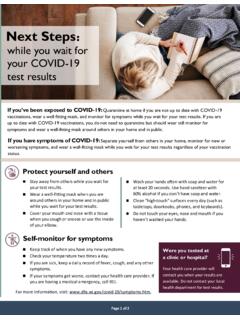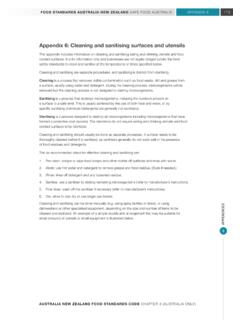Transcription of Five keys to safer food Prevention of Keep clean Foodborne ...
1 Avenue Appia 20 - 1211 Geneva 27 - SwitzerlandPrevention of Foodborne Disease: The Five Keys to safer FoodTo learn more about the Five Keys and potential collaborations, contact:Fran oise Fontannaz Department of Food Safety, Zoonoses and Foodborne Diseases : Keep clean wash your hands before handling food and often during food preparation wash your hands after going to the toilet wash and sanitize all surfaces and equipment used for food preparation Protect kitchen areas and food from insects, pests and other animals Separate raw and cooked Separate raw meat.
2 Poultry and seafood from other foods Use separate equipment and utensils such as knives and cutting boards for handling raw foods Store food in containers to avoid contact between raw and prepared foods Cook thoroughly Cook food thoroughly, especially meat, poultry, eggs and seafood Bring foods like soups and stews to boiling to make sure that they have reached 70 C. For meat and poultry, make sure that juices are clear, not pink. Ideally, use a thermometer Reheat cooked food thoroughly Keep food at safe temperatures Do not leave cooked food at room temperature for more than 2 hours Refrigerate promptly all cooked and perishable food (preferably below 5 C) Keep cooked food piping hot (more than 60 C)
3 Prior to serving Do not store food too long even in the refrigerator Do not thaw frozen food at room temperature Use safe water and raw materials Use safe water or treat it to make it safe Select fresh and wholesome foods Choose foods processed for safety, such as pasteurized milk wash fruits and vegetables, especially if eaten raw Do not use food beyond its expiry dateThere is a growing demand for food safety information at the international, national and local level. Working with WHO s network of regional and national offices and partner organizations, the Five Keys messages can be successfully disseminated all over the world.
4 WHO encourages governments, industry and consumer organizations to disseminate this important food hygiene keys to safer foodEach day thousands of people die from preventable Foodborne diseaseProper food handling is key to Foodborne disease preventionFoodborne disease Is a problem in both developing and developed countries Is a strain on health care systems Severely affects infants, young children, elderly and the sick Creates a vicious cycle of diarrhoea and malnutrition Hurts the national economy and development, and international tradeFood can become contaminated with dangerous microorganisms at any point before simple food hygiene steps can prevent most Foodborne poster is available in a variety of foreign languages in electronic format at.
5 The Five Keys not only prevents illness from eating contaminated food but also contributes to the Prevention of diseases caused by handling infected animals, such as avian is the key to healthWHO actively promotes the adaptation of global health messages to the local level. Educational projects are being implemented at the community level thanks to a contribution from the United Kingdom (DFID). The Five Keys poster has been translated into more than 30 languages. WHO has also developed a Five Keys training manual with tips on how to adapt the training program for different target groups (food handlers, consumers, school children, women).
6 WHO in actionWHO has developed a global food hygiene message with five key steps that promote health. The message explains safe food handling and preparation practices.

















